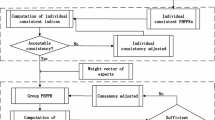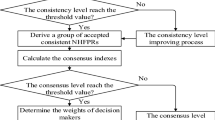Abstract
Interval-valued hesitant fuzzy sets are efficient to denote the hesitant and uncertain judgments of decision makers. To further research the utilization of this type of fuzzy sets, this paper limits to study group decision making (GDM) with interval-valued hesitant fuzzy preference relations (IVHFPRs). First, an additive consistency index is defined for interval fuzzy preference relations, by which we derive a new acceptable additive consistency concept for IVHFPRs. Then, new models based on acceptable additive consistency are built for ascertaining unknown values, and new models for judging the acceptable additive consistency of IVHFPRs are constructed. When the consistency of IVHFPRs is unacceptable, new models based on consistency and uncertain degree are constructed for obtaining acceptable additive consistency IVHFPRs that can ensure the smallest total adjustment and the minimum number of adjusted intervals. For GDM case, a new consensus index is defined to measure the agreement degree of individual judgments. When the consensus level does not satisfy requirement, new models for reaching the additive consistency and consensus requirements are built. Furthermore, a new acceptable additive consistency- and consensus-based algorithm for GDM with incomplete and unacceptable additive consistency IVHFPRs is provided. Finally, an example is given to indicate the utilization of the new algorithm and comparison analysis is made.



Similar content being viewed by others
References
Saaty TL (1980) The analytic hierarchy process. McGraw-Hill, New York
Xu ZS (2007) Intuitionistic preference relations and their application in group decision making. Inf Sci 177(11):2363–2379
Xia MM, Xu ZS (2011) Hesitant fuzzy information aggregation in decision making. Int J Approx Reason 52(3):395–407
Torra V (2010) Hesitant fuzzy sets. Int J Intell Syst 25(6):529–539
Zhang ZM, Wang C, Tian XD (2015) A decision support model for group decision making with hesitant fuzzy preference relations. Knowl Based Syst 86:77–101
Zhang ZM, Wang C, Tian XD (2015) Multi-criteria group decision making with incomplete hesitant fuzzy preference relations. Appl Soft Comput 36:1–23
Xu YJ, Chen L, Rodríguez RM, Herrera F, Wang HM (2016) Deriving the priority weights from incomplete hesitant fuzzy preference relations in group decision making. Knowl Based Syst 99:71–78
Tanino T (1984) Fuzzy preference orderings in group decision making. Fuzzy Sets Syst 12(2):117–131
Zhu B, Xu ZS (2011) Regression methods for hesitant fuzzy preference relations. Technol Econ Dev Eco 19:S214–S227
Tang J, An QX, Meng FY, Chen XH (2017) A natural method for ranking objects from hesitant fuzzy preference relations. Int J Inf Technol Decis Mak 16(6):1611–1646
Meng FY, An QX (2017) An approach for group decision making method with hesitant fuzzy preference relations. Knowl Based Syst 127:1–15
Zhang Z, Kou XY, Yu WY, Guo CH (2018) On priority weights and consistency for incomplete hesitant fuzzy preference relations. Knowl Based Syst 143:115–126
Zhu B, Xu ZS, Xu JP (2014) Deriving a ranking from hesitant fuzzy preference relations under group decision making. IEEE Trans Cybern 44(8):328–1337
Alcantud JCR, Giarlotta A (2019) Necessary and possible hesitant fuzzy sets: a novel model for group decision making. Inf Fusion 46(1):3–76
Farhadinia B, Herrera-Viedma E (2019) Multiple criteria group decision making method based on extended hesitant fuzzysets with unknown weight information. Appl Soft Comput 78:310–323
Galo NR, Calache LDDR, Carpinetti LCR (2018) A group decision approach for supplier categorization based on hesitant fuzzy and ELECTRE TRI. Int J Prod Econ 202:182–186
Hu JH, Yang Y, Zhang XL, Chen XH (2018) Similarity and entropy measures for hesitant fuzzy sets. Int Trans Oper Res 25(3):857–886
Sun G, Guan X, Yi X, Zhou Z (2018) Grey relational analysis between hesitant fuzzy sets with applications to pattern recognition. Expert Syst Appl 92:521–532
Zhou W, Chen J, Xu ZS, Meng S (2018) Hesitant fuzzy preference envelopment analysis and alternative improvement. Inf Sci 465:105–117
Zhou W, Xu Z (2018) Portfolio selection and risk investment under the hesitant fuzzy environment. Knowl Based Syst 144:1–31
Chen N, Xu ZS, Xia MM (2013) Interval-valued hesitant preference relation relations and their applications to group decision making. Knowl Based Syst 37:528–540
Wei GW, Zhao XF, Lin R (2013) Some hesitant interval-valued fuzzy aggregation operators and their applications to multiple attribute decision making. Knowl Based Syst 46:43–53
He YD, He Z, Shi LX, Meng SS (2016) Multiple attribute group decision making based on IVHFPBMs and a new ranking method for interval-valued hesitant fuzzy information. Comput Ind Eng 99:633–677
Meng FY, Chen XH (2014) An approach to interval-valued hesitant fuzzy multi-attribute decision making with incomplete weight information based on hybrid Shapley operators. Informatica 25(4):617–642
Chen N, Xu ZS, Xia MM (2013) Correlation coefficients of hesitant fuzzy sets and their applications to clustering analysis. Appl Math Modell 37:2197–2211
Meng FY, Wang C, Chen XH, Zhang Q (2016) Correlation coefficients of interval-valued hesitant fuzzy sets and their application based on Shapley function. Int J Intell Syst 31(1):17–43
Farhadinia B (2013) Information measures for hesitant fuzzy sets and interval-valued hesitant fuzzy sets. Inf Sci 240:129–144
Liu Y, Liu J, Hong ZY (2018) A multiple attribute decision making approach based on new similarity measures of interval-valued hesitant fuzzy sets. Int J Comput Intell Syst 11:15–32
Asan U, Kadaifci C, Bozdag E, Soyer A (2018) A new approach to DEMATEL based on interval- valued hesitant fuzzy sets Appl. Soft Comput 66:34–49
Liu ZW, Ming XG, Song WY (2019) A framework integrating interval-valued hesitant fuzzy DEMATEL method to capture and evaluate co-creative value propositions for smart PSS. J Clean Prod 215:611–625
Zhang CQ, Wang C, Zhang ZM, Tian DZ (2019) A novel technique for multiple attribute group decision making in interval-valued hesitant fuzzy environments with incomplete weight information. J Ambient Intell Humaniz Comput 10(6):2429–2445
Tang J, Meng FY (2018) Ranking objects from group decision making with interval-valued hesitant fuzzy preference relations in view of additive consistency and consensus. Knowl Based Syst 162:46–61
Zhang YN, Tang J, Meng FY (2019) Programming model-based method for ranking objects from group decision making with interval-valued hesitant fuzzy preference relations. Appl Intell 49(3):837–857
Orlovsky S (1978) Decision-making with a fuzzy preference relation. Fuzzy Sets Syst 1(3):155–167
Xu ZS (2001) A practical method for priority of interval number complementary judgment matrix. Oper Res Manag Sci 10(1):16–19
Meng FY, An QX, Tan CQ, Chen XH (2017) An approach for group decision making with interval fuzzy preference relations based on additive consistency and consensus analysis. IEEE Trans Syst Man Cybern Syst 47(8):2069–2082
Krejčí J (2017) On additive consistency of interval and fuzzy reciprocal preference relations. Comput Ind Eng 107:128–140
Meng FY, Tang J, Fujita H (2019) Consistency-based algorithms for decision making with interval fuzzy preference relations. IEEE Trans Fuzzy Syst 27(10):2052–2066
Morente-Molinera JA, Kou G, Pérez IJ, Samuylov K, Selamat A, Herrera-Viedma E (2020) A group decision making support system for the Web: how to work in environments with a high number of participants and alternatives. Appl Soft Comput 68:191–201
Liang YY, Qin JD, Martínez L, Liu J (2020) A heterogeneous QUALIFLEX method with criteria interaction for multi-criteria group decision making. Inf Sci 512:1481–1502
Morente-Molinera JA, Wu X, Morfeq A, Al-Hmouz R, Herrera-Viedma E (2020) A novel multi-criteria group decision-making method for heterogeneous and dynamic contexts using multi-granular fuzzy linguistic modelling and consensus measures. Inf Fusion 53:240–250
Pérez-Fernández R, Alonso P, Bustince H, Díaz I, Montes S (2016) Applications of finite interval-valued hesitant fuzzy preference relations in group decision making. Inf Sci 326:89–101
Zhai YL, Xu ZS (2019) Consistency checking and improving for interval-valued hesitant preference relations. Symmetry 11(4):466
Chen WJ, Zou Y (2020) Group decision making under generalized fuzzy soft sets and limited cognition of decision makers. Eng Appl Artif Intell 87:103344
Deli İ (2020) A TOPSIS method by using generalized trapezoidal hesitant fuzzy numbers and application to a robot selection problem. J Intell Fuzzy Syst 38(2):779–793
Zhang YL, Zhang XL, Li M, Liu ZM (2019) Research on heat transfer enhancement and flow characteristic of heat exchange surface in cosine style runner. Heat Mass Transfer 55:3117–3131
Zhang YL, Huang P (2020) Influence of mine shallow roadway on airflow temperature. Arab J Geosci. https://doi.org/10.1007/s12517-019-4934-7
Zhang XL, Zhang YL, Liu ZM, Liu J (2020) Analysis of heat transfer and flow characteristics in typical cambered ducts. Int J Therm Sci 150:106226
Acknowledgements
This work was supported by the Startup Foundation for Introducing Talent of NUIST (No. 2020r001), the National Natural Science Foundation of China (No. 71571192) and the Beijing Intelligent Logistics System Collaborative Innovation Center (No. 2019KF-09).
Author information
Authors and Affiliations
Corresponding author
Ethics declarations
Conflict of interest
We declare that we have no conflict of interest.
Additional information
Publisher's Note
Springer Nature remains neutral with regard to jurisdictional claims in published maps and institutional affiliations.
Rights and permissions
About this article
Cite this article
Tang, J., Zhang, Y., Fujita, H. et al. Analysis of acceptable additive consistency and consensus of group decision making with interval-valued hesitant fuzzy preference relations. Neural Comput & Applic 33, 7747–7772 (2021). https://doi.org/10.1007/s00521-020-05516-z
Received:
Accepted:
Published:
Issue Date:
DOI: https://doi.org/10.1007/s00521-020-05516-z




